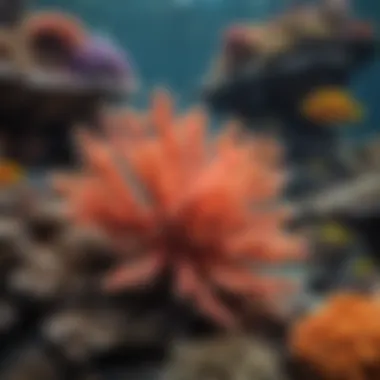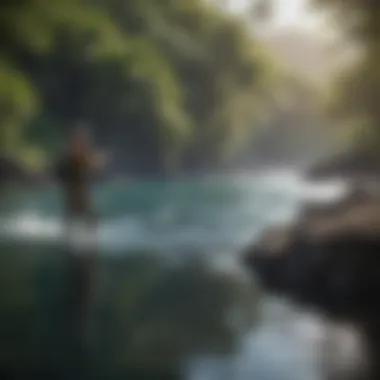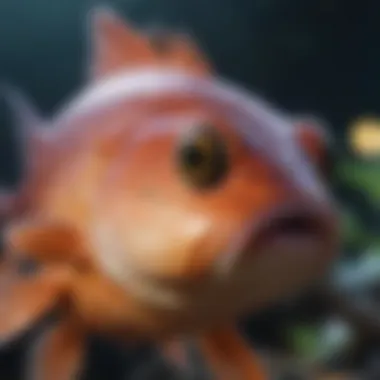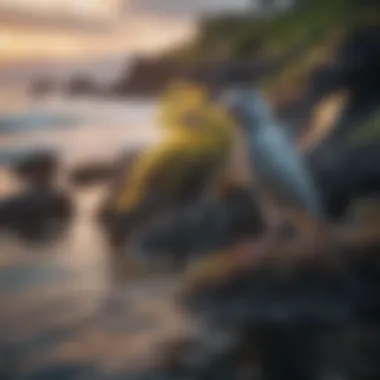Discovering the Diverse Marine Life of Kona, Hawaii


Intro
Kona, Hawaii, is renowned for its rich marine biodiversity, attracting both researchers and enthusiasts. The aquatic life in this region is diverse and includes a multitude of fish species, each with unique characteristics and roles within their ecosystem. Understanding this vibrant underwater world is essential, not just for appreciation but also for fostering responsible fishing and conservation practices. This section serves as a gateway into the intricate and fascinating realm of Kona's aquatic life.
Animal Species Profile
Intro to the animal species
The waters off Kona are home to various fish species, ranging from the widely recognized to the lesser-known. Species like the Yellow Tang and Humuhumunukunukuapua'a stand out for their vibrant colors and distinctive shapes. The tropical waters create an ideal environment for these fish, influenced by unique currents and temperature ranges. In this section, we will explore some key species in more detail and highlight their importance in the ecosystem.
Physical characteristics and appearance
Each species found in Kona has physical traits that aid in its survival. For instance, the Moorish Idol is known for its flat body and elongated dorsal fin, making it easily recognizable. In contrast, the Triggerfish exhibits a more robust and rounded physique, demonstrating adaptability in rocky habitats.
Natural habitat and distribution
Kona's marine environment includes coral reefs, rocky shorelines, and oceanic depths. These habitats support various species, each adapted to flourish in their particular niches. The presence of coral reefs provides essential shelter and feeding grounds, allowing fish like the Clownfish to thrive alongside more solitary species such as the Napoleon Wrasse.
Behavior and social interactions
Social structures form a key part of marine life in Kona. Many fish species exhibit schooling behavior, which offers protection from predators. For example, Surgeonfish often travel in schools while grazing on algae. Others, like the Parrotfish, are more territorial, displaying aggressive behaviors to defend their feeding territories. Understanding these interactions not only adds depth to our knowledge of marine life but also highlights the complex relationships that exist in these underwater communities.
Conservation & Wildlife Efforts
Overview of conservation status
Many species in the waters of Kona face threats due to environmental changes, overfishing, and pollution. Conservation status varies, where some species, such as the Humphead Wrasse, are threatened, while others, like the Inverse Damselfish, remain stable. Evaluating the conservation status helps prioritize efforts in protecting these vital marine resources.
Threats to the species
The key threats impacting aquatic life in Kona include:
- Overfishing, targeting specific species leading to population decline
- Habitat degradation caused by coastal development and pollution
- Climate change affecting water temperature and ocean acidification
Conservation initiatives and organizations
Various organizations are dedicated to marine conservation in Kona. Groups like the Hawaii Wildlife Fund and the Ocean Conservancy actively work toward protecting habitats and educating the public about sustainable practices. They engage in initiatives like cleaning beach areas and establishing marine protected zones.
Success stories and impact
Conservation efforts in Kona have yielded positive changes, such as the resurgence of certain fish populations in protected areas. For example, the establishment of the Kona Coast Conservation Project created zones where fishing is restricted, allowing ecosystems to recover.
Finale
Kona's unique aquatic life requires a blend of appreciation, respect, and responsible management. By exploring various fish species, understanding the ecosystem, and advocating for conservation, we can play a role in preserving this remarkable environment for future generations.
Overview of the Marine Environment in Kona
Exploring the marine environment in Kona is essential for understanding the rich underwater ecosystem that thrives in this area. This region, located along the western coast of the Big Island of Hawaii, is characterized by unique geographic and oceanographic features that create a diverse and vibrant habitat for a variety of aquatic species. The importance of this section lies not only in recognizing the beauty of the marine world but also in acknowledging the ecological balance that supports it.
The health of Kona's waters affects local biodiversity and fishing practices, both of which are crucial for the economic sustainability of the region. As the article unfolds, we will examine the specific elements and benefits justifying the significance of this marine environment.
Geographic and Oceanographic Features
Kona’s marine environment is greatly influenced by its geographical position and oceanographic conditions. The coastline is dotted with lava formations, which provide shelter and breeding grounds for numerous marine species. The water is warm and clear, offering excellent visibility for divers and snorkelers. The currents in the area, such as the Hawaii Lee Current, play a vital role in shaping local marine life by transporting nutrients and fostering biodiversity.
- Key geographic features:
- Volcanic rock formations
- Sandy beaches with coral-dominated reefs
- Numerous bays and coves
Understanding these features is essential for grasping how they contribute to Kona's rich marine ecosystem. The variation in depth and structure along the coastline creates microhabitats that are important for different species.


Coral Reefs and Their Importance
Coral reefs are one of the most crucial components of the marine environment in Kona. They serve as habitats for many fish species, marine invertebrates, and other organisms, establishing a complex underwater community. Healthy reefs support not only marine biodiversity but also the local fishing industry and tourism.
Some significant aspects of coral reefs in Kona include:
- Biodiversity Hotspots: Reefs are home to a stunning variety of species, including endemic fish and other wildlife that depend on this habitat for survival.
- Natural Coastal Protection: Coral reefs act as barriers against ocean waves, protecting coastlines and reducing erosion.
- Economic Value: They contribute significantly to tourism, attracting divers and snorkelers who wish to experience their beauty.
Protecting coral reefs is more than just a matter of conservation; it is essential for sustaining local livelihoods and the ecological balance of the region.
In summary, the marine environment in Kona is shaped by intricate geographic and oceanographic features with coral reefs playing a pivotal role in sustaining life and supporting the local economy. Understanding this context is crucial for appreciating the region's aquatic biodiversity and the challenges it faces.
Key Fish Species in Kona
The waters of Kona are home to an intriguing collection of fish species, each contributing significantly to the region's marine ecosystem. Understanding these species is not only vital for anglers but also for conservationists, enthusiasts, and everyone interested in marine biodiversity. This section will explore the popular game fish and endemic species that thrive in Kona's rich waters.
Popular Game Fish
Marlin
Marlin is one of the most sought-after species in Kona. Its size and strength make it a thrilling challenge for sport fishing. Marlin can be found year-round, with peak seasons varying based on species. They are known for their acrobatic jumps and fast swimming, often reaching speeds of up to 50 miles per hour. This key characteristic makes them a prized catch among anglers.
Additionally, marlin play a crucial role in maintaining the ocean ecosystem. Their presence indicates healthy bait fish populations, which is an essential part of the marine food web. However, successful catch and release practices are vital for ensuring their sustainability.
Yellowfin Tuna
The yellowfin tuna is another popular game fish in Kona, revered for its culinary value and speed. Known for its vibrant colors and strong fighting ability, it is a favorite among local fishermen. Yellowfin tuna are typically more abundant from May to August, making this the prime season for fishing.
A unique feature of yellowfin tuna is its capability to sustain high-speed bursts, allowing it to escape predators and anglers alike. This species contributes significantly to the local economy, not just through recreational fishing, but also via commercial sales within the fisheries sector, making it an important species for various stakeholders.
Snapper
Snapper is also a key fish species in Kona. Known for its diverse habitats, snapper can be found in deeper reefs and rocky areas. This adaptability allows it to thrive in different environments. The most common types of snapper found in Kona include the pink snapper and the yellowtail snapper. Both varieties are favored for their excellent flavor, making them a common target for both recreational and commercial fishers.
The primary advantage of targeting snapper is their abundance in the region. However, snapper populations can be sensitive to overfishing and habitat degradation, underscoring the importance of sustainable fishing practices to maintain their numbers.
Endemic Species
Aholehole
Aholehole, or the Hawaiian Hawaiian mullet, is an endemic species in the waters of Kona. Known for its unique lifecycle, the aholehole migrates from the ocean to freshwater streams for breeding. This characteristic makes it a vital link between freshwater and marine ecosystems. Additionally, their availability is consistent throughout the year, providing great opportunities for anglers. The aholehole's adaptability to both environments allows it to thrive despite various challenges.
Uhu
Uhu, or parrotfish, adds value to Kona's marine biodiversity. These fish are known for their vibrant colors and prominent beaks, which they use to graze on algae. This feeding behavior plays a crucial role in maintaining the health of coral reefs, as it helps control algae growth. Uhu are often sought-after for their taste and are a sustainable option for local fishermen.
One challenge with uhu is its vulnerability to habitat loss. Conservation efforts are essential to protect this beneficial species and ensure its survival in the ecosystem.
Manini
Manini, or the convict tang, is a smaller, endemic fish found in Kona reefs. Their striking black and white stripes make them easy to identify. While they are not typically targeted by sport fishermen, they contribute significantly to coral health by feeding on algae. Their presence in the coral reef ecosystem is an indicator of overall marine health.
Fishing Techniques in Kona
Fishing in Kona, Hawaii, encompasses a rich tapestry of methods that have developed over time. Each technique offers unique benefits and challenges, contributing to the region's vibrant fishing culture and economy. Understanding these methods allows both tourists and locals to respect and navigate fishing practices effectively. Moreover, it emphasizes sustainable practices that are essential for maintaining fish populations and marine life.
Deep-Sea Fishing
Deep-sea fishing is one of the most coveted techniques in Kona. This method involves venturing far from the shore, often several miles into the open ocean, where deeper waters abound with a variety of fish species. Popular target species include Marlin, Yellowfin Tuna, and Mahi-Mahi. These fish not only provide a thrilling challenge for anglers but also contribute significantly to the local economy through fishing charters.
The gear and tactics for deep-sea fishing differ from other methods. Experienced anglers typically use heavy-duty rods and reels along with larger bait. This equipment is essential for combating the strong currents and the size of the fish. The experience of capturing a big fish from the depths of the ocean provides a unique thrill.


It is crucial for fishers to be aware of regulations regarding deep-sea fishing, including licensing and catch limits. Following these guidelines helps ensure the balance of marine ecosystems.
Shore Fishing
Shore fishing offers an accessible alternative for both locals and visitors. This technique allows anglers to fish from the beach or rocky shorelines, making it feasible for those without boats. Target species in these areas include Snapper, Goatfish, and various reef fish. The simplicity of shore fishing makes engaging in this practice appealing.
The benefits of shore fishing include the opportunity to explore Hawaii's beautiful coastlines while enjoying a serene experience. Anyone can fish from the shore after obtaining the necessary permits. It’s essential to remember to practice catch and release for smaller species to maintain population stability.
Night Fishing Practices
Night fishing in Kona is a unique experience that draws both amateur and seasoned anglers. The cooler temperatures and calm sea conditions create an ideal atmosphere for fishing. Many fish species, such as Uku and Opelu, are more active during the nighttime, increasing the chances of a successful catch.
This technique requires different preparations than daytime fishing, such as using specific bait and lights to attract fish. Anglers may utilize various methods, from simple hand lines to sophisticated setups with multiple hooks. Night fishing often promotes camaraderie among participants, making it a social occasion as well.
Engaging in night fishing is an example of adapting traditional methods to the present day while fostering community connections.
Conclusively, the various fishing techniques in Kona embody the region's connection to its marine resources. Understanding these practices is vital for sustaining the ecological balance while offering enjoyment and economic opportunity to the community.
Conservation Efforts in the Region
Conservation is critical to protecting the intricate marine environment found around Kona, Hawaii. The unique ecosystem in this region faces various pressures that could disrupt the balance of aquatic life. Understanding and supporting conservation efforts can safeguard this marine biodiversity for future generations.
Sustainable Fishing Practices
Sustainable fishing is essential in ensuring fish populations remain stable while allowing local communities to benefit economically. By adhering to practices that do not deplete fish stocks, anglers can contribute to the health of the marine environment. This includes methods such as catch and release, which reduces mortality rates for certain species.
Additionally, using selective gear can help target specific fish without harming other populations. Education about local rules and regulations also plays a vital role. When fishers understand and comply with sustainable practices, it leads to healthier ecosystems.
- The use of barbless hooks can minimize injury to fish.
- Utilizing nets with larger mesh sizes can prevent the capture of juvenile fish, helping them to mature.
Marine Protected Areas
Marine Protected Areas (MPAs) are designated zones where human activity is regulated to preserve marine habitats. In the waters surrounding Kona, these areas serve as sanctuaries for a variety of species, including delicate coral reefs and spawning grounds that are crucial for fish populations.
The establishment of MPAs can lead to several significant benefits:
- Restoration of fish populations, which can migrate freely within and around the MPA.
- Preservation of biodiversity, allowing ecosystems to thrive in their natural state.
- Opportunities for scientific research, providing data on healthy marine habitats.
By safeguarding key habitats through MPAs, Kona’s aquatic life benefits from reduced stressors and can flourish.
Regulations Governing Fishing Activities
Regulations play a critical role in maintaining the health of marine ecosystems in Kona, Hawaii. This section highlights key rules and guidelines that are essential for both responsible fishing practices and the conservation of aquatic life. Understanding these regulations helps ensure that the vibrant marine biodiversity in this area is preserved for future generations. With increased tourism and fishing pressure, these regulations become more vital.
Licensing Requirements
In Kona, fishing licenses are required for both residents and visitors engaging in fishing activities. These licenses serve a dual purpose: they not only allow for the collection of necessary data regarding fish populations, but also ensure that fishers are informed about local regulations. The process for obtaining a fishing license in Hawaii is straightforward. Anglers can apply online or in designated locations such as bait shops or store in the region.
- Types of Licenses: There are different types of fishing licenses depending on whether the individual is a resident or visitor. Licenses can be purchased for varying durations, accommodating both short and long-term fishing enthusiasts.
- Regulatory Compliance: Carrying a valid fishing license ensures that individuals comply with state regulations aimed at protecting marine life. Having a license also benefits fishers in terms of access to essential information, as it links them to educational resources and local fishing events.
The absence of proper licensing can lead to serious penalties, including fines, making it crucial for fishers to be aware of these requirements before engaging in their activities.
Catch Limits and Restrictions
Catch limits and restrictions are implemented to manage fish populations effectively. These regulations are specific to different species, sometimes dictated by the season, size, and number of fish that can be retained.
- Species-Specific Limits: Certain species, such as the marlin or yellowfin tuna, may have stricter limits due to their vulnerability. These limits help reduce overfishing and promote sustainable practices across the fishing community.
- Size Restrictions: Minimum size limits are also established for many species. This enables young fish to reach maturity and reproduce before they are caught, contributing to the long-term health of the population.
It is important to respect catch limits and size regulations, as violations can harm ecological balance and a fisher's reputation.
Understanding and adhering to these regulations is vital not just for the protection of marine life, but also for sustaining the fishing industry in Kona. Each fisher plays a role in ensuring that future generations can enjoy the rich aquatic life that this region offers.


Economic Impact of Fishing in Kona
The fishing industry in Kona is more than just a source of income; it is a vital aspect of its economy and cultural identity. The connection between fishing and the local economy is multifaceted. Understanding this relationship requires an examination of both tourism and fisheries, as they are interwoven in significant ways.
Tourism and Fishing Charters
Kona’s stunning marine life and the opportunity for fishing drawn millions of tourists to the area each year. The fishing charters are a crucial part of the tourism industry, providing visitors with experiences ranging from deep-sea fishing for marlin to casual shore fishing for smaller species.
These charters not only attract tourists but also bolster local businesses. Some of the key points include:
- Job Creation: Fishing charters create jobs for local guides and crew members. Enabling many residents to earn a living from the sea.
- Revenue Generation: Tourists spend money on fishing gear, boat rentals, and lodging, resulting in increased revenue for the local economy.
- Life Enrichment: Experiences in the water deepen the visitors' appreciation for marine life, supporting conservation awareness.
As noted by local fishing charter companies, many tourists leave Kona with unforgettable memories of fishing while also supporting the community. This interaction between recreational fishing and tourism has positive implications for regulatory and conservation initiatives.
Local Economy and Fisheries
The local economy relies heavily on fisheries in Kona. Traditional fish catching practices blend with commercial ventures to bring benefits.
Key aspects of the local economy include:
- Sustaining Livelihoods: Local fishermen often use sustainable practices. This enables them to provide fresh fish to restaurants and markets, supporting communities responsibly.
- Cultural Heritage: Fishing practices in the region often reflect Hawaiian traditions and respect for the ocean, preserving cultural identity while enhancing economic activities.
- Market Opportunities: There is a growing demand for fresh, locally caught fish. Fishermen who sell directly to consumers or restaurants can often receive better prices than those relying on middlemen.
The interplay of tourism and fisheries in Kona illustrates the symbiotic relationship between visitors and the community. Each supports the other, and it emphasizes that the health of fish populations and sustainable practices is crucial for long-term economic viability.
Cultural Significance of Fishing in Hawaii
Fishing holds a crucial place in Hawaiian culture, serving as more than just a means of sustenance. It is interwoven into the thread of community life, economy, and tradition. Understanding the cultural significance of fishing in Hawaii reveals insights into social structures, spiritual beliefs, and environmental stewardship.
Traditional Fishing Practices
Traditional fishing methods in Hawaii are diverse and tailored to local environments. Fishermen often utilized techniques that reflected a deep understanding of marine ecosystems. One of these methods is the use of fish weirs, known as aha, which are wall-like structures built in shallow waters to trap fish during incoming tides. Another common technique is net fishing, which involves using large nets to catch schools of fish.
These practices not only fulfill dietary needs but also embody respect for the ocean's resources. The Hawaiian concept of aina emphasizes the relationship between land, sea, and community. Fishermen operated within a system of belief that acknowledged the connectivity of all life forms, thus ensuring that fishing activities were sustainable.
In addition, fishing practices were often communal events, highlighting the importance of cooperation and sharing within the community. Rituals and prayers, or oli, were performed to honor the sea gods and seek permission to fish. This spiritual connection showcases how fishing extends beyond physical transactions, embracing elements of cultural identity and social cohesion.
Contemporary Cultural Identity
In modern times, fishing remains a significant facet of Hawaiian cultural identity. It continues to influence local cuisine, especially in traditional dishes like poke, which features raw marinated fish. These culinary traditions are celebrated in restaurants and local gatherings, linking generations through shared tastes and experiences.
Furthermore, fishing fosters connections to the land and sea, reinforcing a sense of place. Locals and visitors alike engage in fishing activities, promoting tourism while preserving cultural heritage. Initiatives like community fishponds are being revived, where residents practice ancestral techniques, thus facilitating intergenerational knowledge transfer.
Fishing transcends mere economic activity; it encapsulates values of community, sustainability, and respect for nature.
Despite its challenges from modernization and overfishing, the cultural significance of fishing endures. Various organizations work tirelessly to ensure that Hawaiian traditions are respected, and sustainable practices are adopted. The preservation of these fishing traditions is vital not only for maintaining the ecological balance but also for fostering a profound cultural connection that shapes the identity of Hawaii today.
Challenges Facing Fish Populations
The fish populations in Kona, Hawaii face several significant challenges, impacting both marine ecosystems and local communities. Understanding these issues is vital for anyone interested in fishing, marine biology, or conservation. These challenges are not just environmental; they have implications for cultural practices, economic stability, and the overall health of aquatic life.
Overfishing Concerns
Overfishing remains a pressing issue in the waters off Kona. As fishing technologies advance, the capacity to catch fish has increased substantially. This has led to certain fish species being caught at rates that cannot sustain their populations. Popular species such as Marlin and Yellowfin Tuna have seen steep declines in numbers due to intense fishing pressure.
The economic incentives for fishing businesses amplify the problem. Short-term profits can overshadow long-term sustainability. If fish populations continue to dwindle, local fishermen might find it increasingly difficult to maintain their livelihoods. Additionally, overfishing disrupts the local ecosystem, leading to imbalances that can affect other species.
Climate Change Effects
Climate change is another significant factor impacting fish populations in Kona. Rising sea temperatures threaten coral reefs, which serve as crucial habitats for many fish species. Warmer waters can lead to coral bleaching, making these areas less hospitable for marine life.
Moreover, ocean acidification resulting from increased carbon dioxide levels can alter the behavior and physiology of fish. Some species may struggle to adapt to rapid changes, leading to shifts in fish distribution. Such shifts may cause conflicts between fishermen if popular species migrate to new areas.
Pollution and Its Impact
Pollution poses a serious threat to Kona’s aquatic ecosystems. Agricultural runoff, plastics, and other contaminants find their way into the ocean. This pollution can lead to harmful algal blooms, which deplete oxygen levels and create dead zones where fish cannot survive.
Furthermore, plastics pose direct dangers to marine life. Fish can ingest plastic particles, which can lead to health issues and mortality. As the quality of water decreases, so too does the quality of fish populations, which can ultimately affect local economies and cultures dependent on fishing.
Addressing these challenges requires a combined effort from local communities, policymakers, and conservation organizations to ensure sustainable practices are adopted and maintained.







